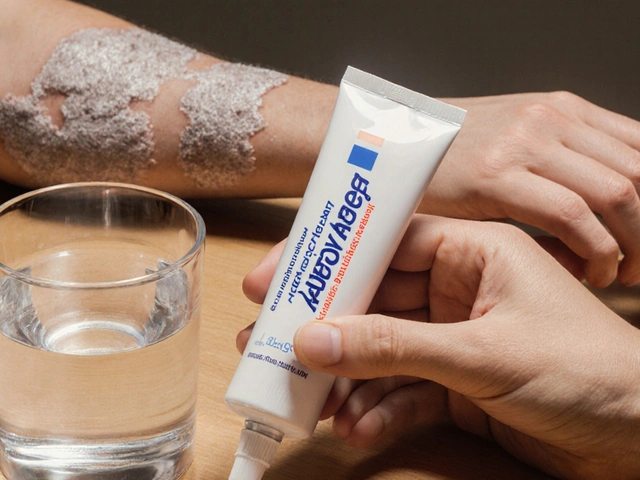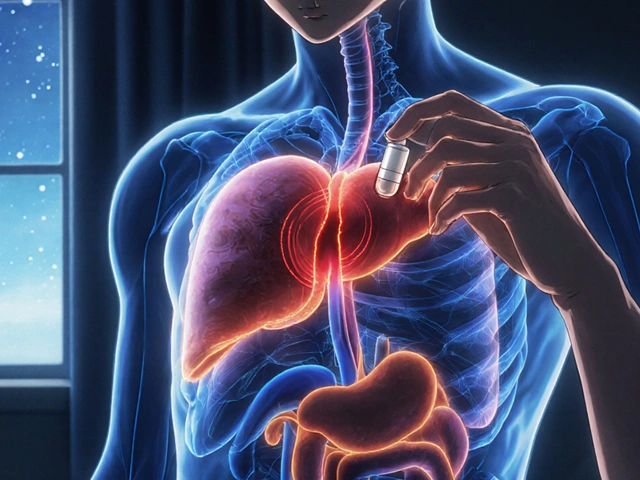
Health June 27, 2025
Imipramine Withdrawal Symptoms, Timeline & Coping Strategies: A Practical 2025 Guide
Your body can completely surprise you when you stop a medication like imipramine. People expect headaches or low mood, sure, but who knew you could wind up with wild dreams or even tingly toes? It’s more common than you think, but scrolling miserable forums on a Tuesday night rarely gives the full story. Maybe your GP handed you a leaflet on withdrawal, but if you’re feeling things they never mentioned, you’re not alone. There are facts, timelines, and practical tactics that can make this whole process far less intimidating—it’s just that nobody explains it in plain English. So let’s get real about what imipramine withdrawal can feel like, why it happens, and how you can navigate those rough patches without losing your sanity (or annoying your pets, like my cat Zephyr, who cannot handle a dramatic human).
What Happens During Imipramine Withdrawal?
Imipramine is an old-school antidepressant, a tricyclic discovered back in the 1950s. It’s prescribed for depression, anxiety, sometimes bedwetting in kids, and even nerve pain. Imipramine works by meddling with your brain’s chemistry—mainly boosting serotonin and norepinephrine. When you suddenly stop, your brain’s used to having help from imipramine, and now it’s on its own. This “chemical gap” triggers withdrawal symptoms, which aren’t just in your head: the physical side can match or even overshadow the emotional side.
The NHS quietly admits that up to 56% of people who stop antidepressants like imipramine have withdrawal symptoms, and about half find it “moderate or severe.” It isn’t just being sad or tired. Symptoms range from mild (like irritability or a bit of nausea) right up to flu-like stuff, insomnia, total brain fog, and what’s much less discussed: odd nerve sensations. I’m talking zaps, tingles, or that weird crawling feeling on your skin, which absolutely no one warned me about.
Here’s a quick look at real symptoms you might spot during withdrawal—that’s straight from patient reports and NHS stats:
| Symptom Type | Most Common Examples | % Patients Affected |
|---|---|---|
| Physical | Nausea, headaches, dizziness, tingly skin | 40-60% |
| Emotional | Anxiety, mood swings, agitation, crying spells | 50% |
| Sleep issues | Insomnia, vivid dreams, nightmares | 35% |
| Other | Flu-like symptoms, sweating, appetite changes | 30% |
And here’s a bit of reality nobody puts on the drug packets: withdrawal isn’t a sign that you’re “weak” or have relapsed, it’s just your nervous system readjusting. According to a 2019 review in the British Journal of Psychiatry, “antidepressant withdrawal can last much longer than previously thought, sometimes several weeks or months.” That’s not cheerfully mentioned in GPs’ offices, but it’s true. Some people breeze through withdrawal, barely noticing. Others will genuinely feel as if they’re falling apart, which makes a sympathetic support network (or even a comfy blanket and a nagging pet) suddenly essential.

Timeline of Imipramine Withdrawal: What to Expect and When
The golden question: how long does it last? There’s no neat answer, which drives people mad. Most folks (me included) just want to know if next week will be better or if it’s normal to feel shaky two months after stopping. Here’s how it goes for the average person, though your mileage may vary. Most withdrawal symptoms kick in within 1-3 days after stopping or cutting your dose sharply. If you’ve tapered slowly, the timeline is less harsh, but small blips can still pop up as your body readjusts.
Here’s a week-by-week breakdown based on research and real-life reports:
- Days 1-3: You may feel totally fine, or you might get hit right away with headache, nausea, or anxiety. Some people don’t feel anything yet—don’t get too comfy.
- Days 4-7: For most, this is when things ramp up. Brain zaps, dizziness, mood swings, and sleep issues can pop up. Nausea or digestive weirdness is common. It can feel like a nasty hangover that won’t quit.
- Week 2: Physical symptoms may settle, but emotional ones like irritation or sadness might linger. Some get insomnia or wild dreams. If your job involves lots of thinking, expect some brain fog.
- Weeks 3-4: Mood usually stabilizes for most, though some physical symptoms might make brief, annoying returns (like dizziness when you stand up too fast). By now, you might just feel tired and a bit flat.
- Month 2 and Beyond: Around 20% still have some symptoms at the two-month mark—usually emotional, not physical. That can mess with your head, but it usually fades soon after.
Remember, everyone’s withdrawal is unique. If you’ve been on imipramine for years (especially at higher doses), symptoms can be more intense and stick around for longer. Genetics, age, and even things like how well you sleep or the food you eat in Bristol’s soggy June can influence your timeline. If your symptoms don’t fade, or if you get anything scary like suicidal thoughts, always check back with your GP. It’s boring advice, but your brain is precious.
"While most withdrawal effects peak within the first two weeks, subtle symptoms may persist for up to three months in some cases" – Royal College of Psychiatrists, 2023 guidance on discontinuation.
One more nerdy-but-useful fact: a gradual taper (slowly lowering your dose, sometimes by just 10-25mg every few weeks) reduces your risk of severe withdrawal by more than half, according to studies published in JAMA Psychiatry. If your doctor suggests stopping cold turkey, ask about tapering options instead. Slow and steady is less miserable, and more likely to keep you comfortable—plus, it gives you time to catch up on all those Bristol rainy-day Netflix shows while you adjust.

Practical Coping Strategies for Imipramine Withdrawal
This is where your day-to-day habits can really make a difference. Nobody wants to be told to meditate for the thousandth time, but there are actually practical things you can do that help a ton. First up: don’t go it alone. Even if you want privacy, keep one or two trusted people in the loop. Withdrawal can make you grumpy, jumpy, and overly sensitive—it’s easier if others know what’s going on. I had to warn my flatmate and make up a code word for “I need space; please hand me tea and walk away.”
It helps to stick to a routine as much as possible, even on rough days. Waking up at the same time, eating decent meals, and keeping hydrated can keep symptoms more manageable. Light exercise (even just a walk around a Bristol park if it isn’t pouring) does surprisingly well at boosting mood and reducing physical tension. I used to walk Zephyr in a cat harness, which probably helped me more than him.
To ease edgy physical symptoms:
- Ginger tea or ginger chews can help with nausea.
- If you feel dizzy, move slowly and give yourself extra time to get up from bed or chairs.
- For headaches, consider cool packs or a magnesium supplement (after checking with your doctor).
- For tingling or zaps, some people find stretching or gentle yoga helps calm the nervous system.
Mental tricks work, too. Distraction really can dampen the worst moments. Phone a friend, dive into an easy read, or try puzzling games that don’t demand deep concentration. Some swear by keeping a symptom diary—writing down what you feel each day. It helps you notice improvement, which is motivating, and spot patterns you might otherwise miss.
Sleep is the ugly battleground. Withdrawal can really wreck your normal sleep, triggering wild dreams and weirdly timed wake-ups. Keep your phone out of the bedroom if you can and set a wind-down routine: same time every night, screens off an hour beforehand, and maybe a warm shower. If you can, avoid caffeine after mid-afternoon. If nightmares hit, jot them down and try to let them go. They’re a sign your brain’s rewiring, not that you’re losing the plot.
Nourish yourself, too. Imipramine withdrawal sometimes kills your appetite, but your body needs steady fuel to recover. Foods rich in complex carbs—like brown toast with peanut butter, or porridge—help balance blood sugar and mood. A weird but reliable snack from my own kitchen: oatcakes with cheese, which seem to soften nausea and keep my energy up.
If you’re tempted to dive back onto imipramine just to escape withdrawal, talk it through first. Sometimes doctors do recommend a brief “rescue dose,” but often just waiting out a few more days makes all the difference. And if symptoms get so severe you can’t function—like constant vomiting or thoughts of self-harm—call your GP or an emergency line. It’s not dramatic, it’s sensible self-care.
Support groups can be a lifeline. There are UK-based groups on Facebook and even local in-person meetings (check your community noticeboards), where you’ll get empathy and practical, non-judgmental advice. Don’t underestimate the power of venting to someone who’s been there.
To sum up, while imipramine withdrawal can knock you sideways, it’s survivable. Go gently, stay connected, lean on silly routines or cuddly pets, and give your brain space to reset. As the Royal College of Psychiatrists says, “Recovery is the rule, not the exception.” Don’t let the scary bits drown out all hope—your nervous system is tougher than you think.
And hey, if all else fails, there’s always a soft blanket, a purring cat, and, if you’re like me, the endless distraction of watching seagulls outside your window plotting to steal your lunch.
Write a comment
Items marked with * are required.






20 Comments
Jenna Hobbs June 28, 2025 AT 09:33
I was on imipramine for 8 years and stopped cold turkey because my doctor said it was 'outdated.' Big mistake. The brain zaps felt like tiny electric shocks in my skull. I cried for three days straight. But here’s the thing-I made it. And now? I’m sleeping through the night without meds. You’re not broken. You’re rebirthing.
PS: My cat also started sleeping on my chest like a tiny therapist. Pets are unsung heroes.
Ophelia Q June 29, 2025 AT 06:33
I felt the tingles too 😭 I thought I was having a stroke. Turned out it was withdrawal. Took me 6 weeks to feel human again. Ginger tea + 10-min walks = my lifeline. You’re not alone. I’m rooting for you 🌱❤️
Elliott Jackson June 29, 2025 AT 20:55
Look, I get it. But let’s be real-this whole 'withdrawal is normal' narrative is just pharma’s way of keeping you doc-dependent. You don’t need a guidebook. You need to stop blaming your brain and start taking responsibility. If you can’t handle the side effects, maybe you shouldn’t have taken it in the first place.
McKayla Carda June 30, 2025 AT 09:46
Tingly toes? Yes. Brain zaps? Oh god yes. I thought I was dying. But I didn’t. And neither will you. Just breathe. You’ve got this.
Christopher Ramsbottom-Isherwood July 2, 2025 AT 05:51
I’m sorry, but this whole post reads like a wellness influencer’s sponsored content. Imipramine withdrawal isn’t some mystical journey-it’s a pharmacological glitch. The NHS stats? Overblown. Most people feel fine after a week. Stop dramatizing.
Stacy Reed July 2, 2025 AT 20:51
I wonder if the real issue isn’t the drug, but the society that pushes antidepressants like candy. We medicate sadness instead of fixing the systems that make people sad. Are you really healing, or just surviving a system that won’t let you feel?
Robert Gallagher July 3, 2025 AT 20:00
I stopped imipramine cold turkey in 2021 and survived. No guide. No tea. Just grit. If you’re feeling weak, that’s your brain talking, not your soul. Get up. Walk. Breathe. Repeat. You’re tougher than you think. I did it. You can too.
Howard Lee July 3, 2025 AT 23:32
The Royal College of Psychiatrists’ 2023 guidance is accurate: withdrawal symptoms can persist for up to three months in some individuals. This is well-documented in peer-reviewed literature. Tapering reduces severity by approximately 58% (JAMA Psychiatry, 2020). Please consult your prescriber before discontinuing.
Nicole Carpentier July 4, 2025 AT 01:30
I’m from NYC and I thought I was the only one who got zaps. Turns out? Everyone. I started journaling and now I’ve got 17 pages of ‘what I felt on day 12.’ It’s weird. It’s gross. But it’s helping. Also, my dog licks my hand when I cry. Best therapy.
Hadrian D'Souza July 5, 2025 AT 14:49
Oh wow. A 2025 guide? That’s cute. Like a horoscope for antidepressant withdrawal. Next you’ll be selling crystal-infused imipramine taper kits. Look, if you’re having weird dreams and tingly toes, maybe you’re just an overmedicated millennial who needs a vacation, not a pamphlet.
Brandon Benzi July 7, 2025 AT 14:04
This is why America’s healthcare system is broken. You’re supposed to tough it out. Not cry over ginger tea and cat cuddles. We used to handle this without blogs and emojis. Back in my day, we just took the pill or didn’t. No drama.
Abhay Chitnis July 9, 2025 AT 13:58
I stopped imipramine in Delhi last year. The zaps were insane. But I found Ayurvedic herbs helped-ashwagandha and brahmi. Also, cold showers. Weird? Maybe. But I slept better in 10 days. Don’t just rely on Western medicine.
Vivian Quinones July 9, 2025 AT 18:39
I just want to say: if you’re reading this and you’re scared-you’re not crazy. You’re human. That’s it. That’s the whole thing.
Eric Pelletier July 10, 2025 AT 13:28
From a neuropharmacology standpoint, the 5-HT2A and 5-HT1A receptor downregulation post-SSRI/TCAs is the primary driver of rebound hyperexcitability. The tingling and zaps correlate with transient glutamatergic surges. Tapering mitigates this by preserving synaptic homeostasis. Recommend 10-15% dose reduction every 2-3 weeks.
Marshall Pope July 12, 2025 AT 12:10
i had the brain zaps for like 3 weeks and i thought i was gonna die but then one day they just stopped. no one told me that. just wanted to say you’ll be okay. also my dog stole my socks. it helped.
Nonie Rebollido July 12, 2025 AT 13:34
I’m from Vancouver and I stopped in winter. The dark + the zaps = rough. But I started walking by the ocean every morning. Didn’t fix it, but made it bearable. Also, hot chocolate. Lots of it.
Agha Nugraha July 14, 2025 AT 10:04
I stopped imipramine after 5 years. Took me 14 weeks to feel normal. I didn’t know anyone else went through this. Glad I found this. Thank you for sharing.
Andy Smith July 14, 2025 AT 23:09
I want to add: hydration is critical. Dehydration worsens dizziness and brain fog. I drank 3 liters of water daily during withdrawal. Also, avoid alcohol-it amplifies emotional volatility. And yes, the cat thing? Valid. My cat slept on my chest for 11 days straight. I didn’t mind.
Rekha Tiwari July 15, 2025 AT 22:52
I’m from India and I felt so alone until I found a Reddit group. We shared memes, recipes, and nightmares. One woman sent me a homemade chai blend. I cried. We’re not just patients-we’re a tribe. You’re not alone. I’m here. Always.
Leah Beazy July 17, 2025 AT 14:00
I stopped last month. Day 12: I screamed at my toaster. Day 20: I laughed at a dog video. Day 28: I made pancakes. It’s not linear. But it gets better. And hey-your cat? He’s proud of you.